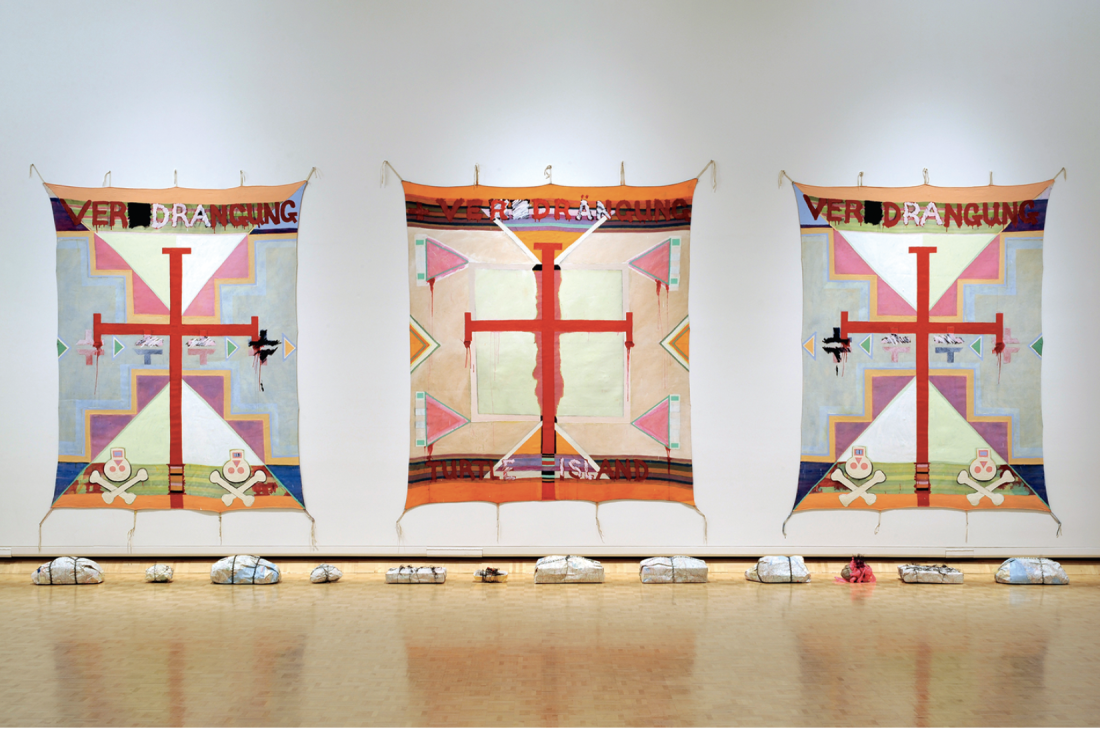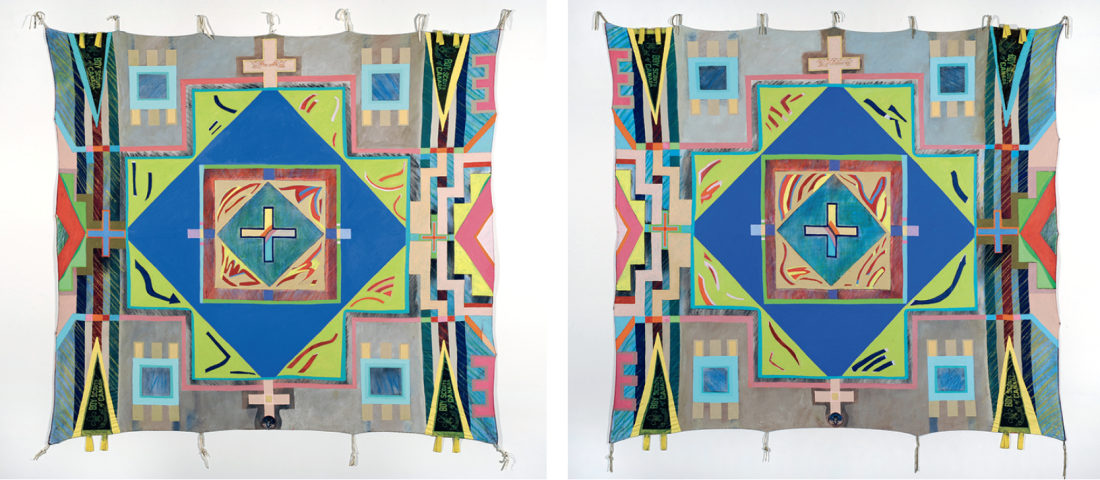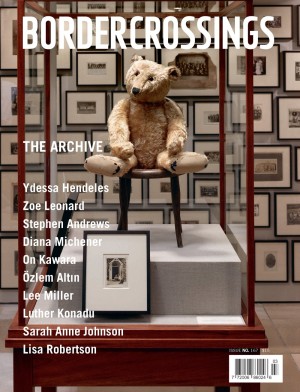Bob Boyer
Bob Boyer’s friends were shocked to hear of his premature passing in 2004 at the age of 56. However, many of us smiled despite ourselves when we learned that he died dancing. Though a professor, university department head, curator, internationally exhibiting artist and cultural leader, he cared less for these roles and successes than he did for the perfect conjunction of the physical and spiritual, social and personal, and the traditional and contemporary offered by pow wow.
For those who never knew the dancer, there remains the legacy of his studio production, and there are traces enough here to warrant a space for him in Canadian art history. On the prairies, Boyer’s paintings are appreciated; in the Aboriginal art world, he is a significant figure; to the rest of Canada, he is less known than he deserves. The retrospective, “Bob Boyer: His Life and Work,” curated for the Mackenzie Art Gallery and the Canadian Museum of Civilization by Lee-Ann Martin, is poised to remedy this situation.
How do people outside the Aboriginal art world read Boyer’s paintings? Many take pleasure in his beautiful designs and recognize his challenges to Canadian history-telling and the treatment of First Nations and Métis people. But a deeper appreciation of his work and an assessment of his achievement requires an understanding of the Aboriginal history, material culture and perspective that led to his practice. This exhibition’s well-written and beautifully produced catalogue records and contextualizes his achievement.

Bob Boyer, Trains-N-Boats-N-Plains: The Nina, the Santa Maria and a Pinto, 1991, road maps, chain, wire, Styrofoam tray, crayon, mixed media and oil over acrylic on blanket, 295 x 730 x 50 cm. Collection of the MacKenzie Art Gallery, purchased with funds from the James Kurtz Memorial Foundation.
Boyer belongs to that generation of First Nations (and a few Métis) creative leaders who swept into prominence in the 1970s and became national and international cultural forces by the ’80s and ’90s. In those heady days, Tom Hill, Robert Houle, Gerald McMaster, Joanne Cardinal-Schubert, Jim Logan, Alfred Young Man (and too many others to list) recognized that racism and Aboriginal rights were not only a personal but also a collective struggle. Unlike previous generations, they did not feel powerless.
In the 1970s, a handful of “Indian” artists enjoyed commercial success but were frustrated that their work went unrecognized by public galleries, critics and scholars. This group consisted of bright, university- educated people who were aware of these omissions and earned the mainstream tools to address the situation from within. They saw that post-colonial critique—the challenging of stereotypes and incomplete or false histories and the assertion of contemporary Aboriginality—was vital to the cultural renaissance. But they also asserted that fundamental change would only come when Aboriginal people actually occupied institutional positions. This consciousness lead to a flowering of polymaths, artists who not only produced studio work and managed their careers, but also made their way as curators, administrators, teachers, writers and founders of artist and advocacy collectives. The learning curve and stress must have been enormous—as was the impact.
Bob Boyer was in the centre of this movement. Hired by the newly formed Saskatchewan Indian Federated College (later the First Nations University of Canada) in 1976, he responded to his new responsibilities by joining SCANA (the Society of Canadian Artists of Native Ancestry) and shifting from depictions of vaguely Indian shields to the work he is best known for: the “Blanket Statements.” Begun in 1983, and more or less concluded in the decade before his death, these colourful paintings on flannel sheets, blankets, burlap and unstretched canvas combine geometric abstraction and symbols from First Nations sources with playful references to mainstream abstract painting. The primary source is Sioux beading and parfleche bags, the thick rawhide folded containers favoured by various Northern Plains people. Boyer found in their bold colours and formal beauty not only a complement to the non-objective painting he learned at university but also a precursor, even an influence, on that tradition. As Lee-Ann Martin explains, “Rather than painting a picture of a parfleche, he treated the canvas as a parfleche upon which he paints.” Rather than depict Indian art from the outside, he makes it anew from the inside as an Aboriginal artist.
Parfleche; Handle with Care is a transitional painting. Objects are either coming into form or being destroyed. The spray of red at the centre might either be a nod to the abstract expressionism he is about to part company with or an evocation of our violent history. Blood spills in A Minor Sport in Canada, Batoche Centennial and several other paintings of this period. Within a few years, however, Boyer turned from anger to mourning and then to humour.

Bob Boyer, Hewey, Dewey and Lewey Wannabee: A Reappropriation of Mis-appropriated Appropriation (formerly Huey, Dewey and Louis Wannabee), 1988–90, diptych, oil and mixed media collage on blanket, 218 x 232 cm each. From the collection of the Canada Council for the Arts Art Bank.
Most of the “Blanket Statement” paintings balance a will to beauty and order based on traditional motifs, with a need to comment on messy past and contemporary conditions. At first glance, his compositions appear to be simply decorative. It is only after reading the title, re-examining the symbols and recalling the referred to event that the content makes sense. The seemingly benign and non-objective FUSQ—Tanks for the Memories is actually a bird’s-eye view of the oka conflict with Mohawk people surrounded by the SQ (Sûreté du Québec, provincial police force). Boyer’s paintings, like much traditional Aboriginal material culture, appear to be non-objective pattern making when they are, in fact, coded witnesses.
Hewey, Dewey and Lewey Wannabee: A Re-appropriation of Misappropriated Appropriation (formerly Huey, Dewey and Louie Wannabee), 1988–90, is the climax of Boyer’s ironic period. It consists of two grey blankets covered in a complex grid of geometric designs. In part they resemble Navajo blankets and Boyer’s other work, but something is off. Up close, you recognize eight Boy Scout pennants and other “Indian” motifs worked into the design. The paintings critique the ambiguous relationship the dominant culture has with Aboriginal people: the romantic desire to appropriate aspects of “Indianess” while wishing Aboriginal people did not exist. The painting might also be a warning to the artist himself—that irony eventually folds in on itself. It is difficult to be productive and sincere from inside an ironic mode. Aboriginal artists who build their careers critiquing the dominant society do raise consciousness and play the art game, but they may risk losing their home audience.
In his final phase, Boyer developed a more expansive vision. The paintings are not overtly political; instead they are personal and/or metaphysical. He turned from history and pain toward healing through universal themes. He consolidated his broad academic research (he taught Indian Art history) with an expanded sense of Indigeniety and humanity gleaned from his inter-tribal encounters along the pow-wow trail, and travels in China, Europe and throughout the Americas. He filtered all this experience through a personal sensibility informed by traditional teachings and dreams. This is his visionary period. His visual language builds on a regional vocabulary of horses, birds, teepees, trees and mountains, and expands to include Mayan pyramids and more universal symbols familiar to Aboriginal cosmologies, such as four direction forms, intersections and swastikas. As a spiritual man in a primarily secular setting, a Métis who joined the First Nations powwow circuit, and as a hog-riding, t-shirt wearing guy who also ran a university department and sat on numerous boards, Bob often found himself a mediator between worlds.
Even though his life was cut short, the full arc of his work suggests that he reached a sense of contentment, a resolution. He has left a legacy to be enjoyed and an example to follow. Pow wow was the embodied metaphor of Bob Boyer’s life, and, as is evidenced by this wonderful exhibition, his finest paintings approach the perfection of the dance. ❚
“Bob Boyer: His Life’s Work” was exhibited at the MacKenzie Art Gallery in Regina from September 20, 2008, to January 18, 2009. The exhibition will travel to the Winnipeg Art Gallery in January 2010 and to the Mc- Michael Canadian Art Collection in June 2010.
David Garneau is a painter, writer, curator and Associate Professor of Visual Arts at the University of Regina.

